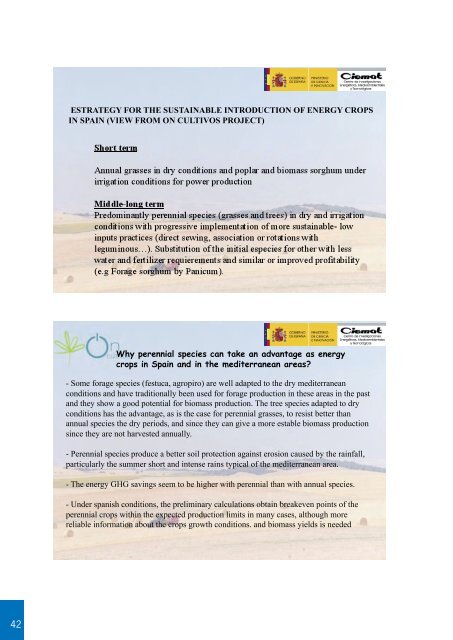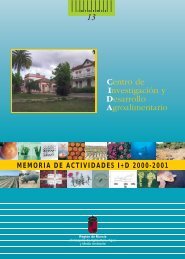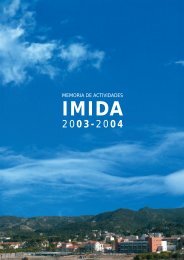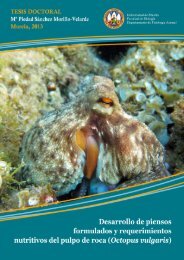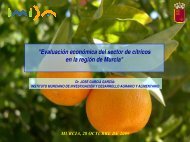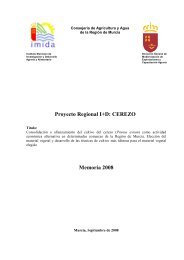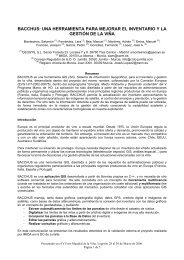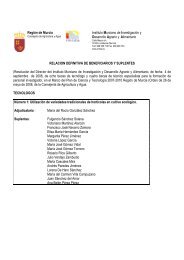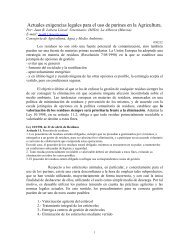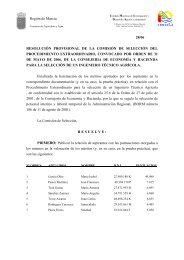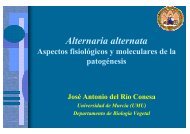- Page 3 and 4: SERIE DIVULGACIÓN TÉCNICA Institu
- Page 5: Índice de contenidos Introducción
- Page 8 and 9: degna (Italia), la Región de Apuli
- Page 11: Programa del Seminario y Poster 11
- Page 14 and 15: PROGRAMME imida 1st day: 8 SEPTEMBE
- Page 17: Intervenciones Presentación en ing
- Page 20 and 21: Main objectives of the project Gene
- Page 22 and 23: What is a « Sustainable Mediterran
- Page 24 and 25: Possible criteria for the implement
- Page 26 and 27: Some considerations and facts on bi
- Page 28 and 29: DENERAL DATA OF On Cultivos PROJECT
- Page 30 and 31: Preliminary evaluation results with
- Page 32 and 33: Preliminary evaluation results ofSo
- Page 34 and 35: Preliminary evaluation results of s
- Page 36 and 37: Experiemental parcels in On Cultivo
- Page 38 and 39: Panicum virgatum var. Cave in Rock
- Page 40 and 41: Andropogon gerardii var. Roundtree
- Page 44 and 45: Correlation between economic and en
- Page 46 and 47: Energy crops for marginal rainfed l
- Page 48 and 49: ECONOMICAL • Energy production in
- Page 50 and 51: PRESELECTION OF NATIVE SPECIES OF M
- Page 52 and 53: May 2010 IRRIGATED June 2010 RAINFE
- Page 54 and 55: Other yields during 2010 (Plant den
- Page 56 and 57: CONCLUSIONS •There is not a globa
- Page 58 and 59: Marginal croplands 1956 Environment
- Page 60 and 61: Marginal croplands • mediterranea
- Page 62 and 63: Objective crops Environmental impac
- Page 64 and 65: Environmental impacts of energy cro
- Page 66 and 67: A new balance? • Aethiessa floral
- Page 68 and 69: Steppe birds • Lek: : grouping of
- Page 70 and 71: Sustainable management of Mediterra
- Page 72 and 73: NOVAGRIMED PROGRESS UNTIL 2011: Tec
- Page 74 and 75: NOVAGRIMED PROGRESS UNTIL 2011: Leg
- Page 76 and 77: NOVAGRIMED FORESTRY MYTHS AND LEGEN
- Page 79: AUTONOMOUS COMMUNITY: Consejería d
- Page 82 and 83: FIREWOOD AND TIMBER PRICE AID FOR S
- Page 84 and 85: Les phases préliminaires du plan d
- Page 86 and 87: Les outils GIS pour le district agr
- Page 88 and 89: Les outils GIS pour le district agr
- Page 90 and 91: Les outils GIS pour le district agr
- Page 92 and 93:
Les outils GIS pour le district agr
- Page 94 and 95:
Le Plan du district agro - énergé
- Page 96 and 97:
). Les principaux obstacles au dév
- Page 98 and 99:
1- Type of biomass sources and wher
- Page 100 and 101:
1- Type of biomass sources and wher
- Page 102 and 103:
2- Communication infraestructures d
- Page 104 and 105:
3- Biomass cost transport. The mode
- Page 106 and 107:
4- Example maps produced. Potencial
- Page 108 and 109:
108
- Page 110 and 111:
€mn €
- Page 112 and 113:
112 PECS (Hungary)
- Page 114 and 115:
114
- Page 116 and 117:
1 ) 4
- Page 118 and 119:
Machinery and mechanization Francis
- Page 120 and 121:
INDUSTRIAS DAVID S.L.U. Nuestras In
- Page 122 and 123:
INDUSTRIAS DAVID S.L.U. Nuestros pr
- Page 124 and 125:
No se pude mostrar la imagen vincul
- Page 126 and 127:
INDUSTRIAS DAVID S.L.U. Nuestros pr
- Page 128 and 129:
Pinza hidráulica: Prensado y vacia
- Page 130 and 131:
25 26 130
- Page 132 and 133:
Technologies for biomass conversion
- Page 134 and 135:
120.000 100.000 80.000 Electricity
- Page 136 and 137:
Efficiency in the use of biomass: H
- Page 138 and 139:
Mauenheim before becoming a "Bioene
- Page 140 and 141:
Overview on different feedstocks fo
- Page 142 and 143:
Small- scale biomass combustion sys
- Page 144 and 145:
, Large- scale combustion systems w
- Page 146 and 147:
, Ash related problems • fine par
- Page 148 and 149:
Reducing of slagging by fuel- addit
- Page 150 and 151:
Combustion of spelt husks in an und
- Page 152 and 153:
Quality and Standardization of biom
- Page 154 and 155:
Quality & Standardization of biomas
- Page 156 and 157:
Quality & Standardization of biomas
- Page 158 and 159:
Quality & Standardization of biomas
- Page 160 and 161:
Quality & Standardization of biomas
- Page 162 and 163:
Quality & Standardization of biomas
- Page 164 and 165:
políticas para esta Región; b) la
- Page 166 and 167:
- reconocer institucionalmente el c
- Page 168 and 169:
medidas de apoyo. Su uso puede ince
- Page 170 and 171:
2) cultivos leñosos como el chopo
- Page 172 and 173:
Un sistema de doble cultivo cereal/
- Page 174 and 175:
A medio-largo plazo interesan predo
- Page 176 and 177:
- 35% ahorro mínimo emisión GEI r
- Page 178 and 179:
lo que indica que, en cualquier cas
- Page 180 and 181:
Cada una de las especies tiene un
- Page 182 and 183:
- Jatropha curcas • Daños por fr
- Page 184 and 185:
- encontrarse por debajo del umbral
- Page 186 and 187:
- cambios en el manejo de la tierra
- Page 188 and 189:
jilgueros por ejemplo. Aunque la p
- Page 190 and 191:
En el periodo 2011-2013, con el pro
- Page 192 and 193:
EVALUACIÓN DE LA ENERGÍA Y GESTI
- Page 194 and 195:
Comarca del Noroeste: Moratalla, Ca
- Page 196 and 197:
• usos actuales y potenciales de
- Page 198 and 199:
- caracterizar y analizar las tipol
- Page 200 and 201:
IMPLEMENTACIÓN DE DISTRITOS BIOENE
- Page 202 and 203:
Ejemplos de mapas producidos Alguno
- Page 204 and 205:
¿Qué es Dalkia? Dalkia es una com
- Page 206 and 207:
Finalmente, los objetivos de Dalkia
- Page 208 and 209:
energía eólica, seguida por la bi
- Page 210 and 211:
para el suministro de calor), en la
- Page 212 and 213:
CALIDAD Y NORMALIZACIÓN DE BIOMASA
- Page 214 and 215:
• AVEBIOM es miembro fundador del
- Page 216 and 217:
Discusión y debate Presentación d
- Page 218 and 219:
Presentación de Juan Esteban Carra
- Page 220 and 221:
Presentación de María Sánchez, C
- Page 222 and 223:
Presentación de Francisco Carreño
- Page 224 and 225:
Presentación de Pablo Aledo Martí
- Page 226 and 227:
(P8) Juan Pedro Solano, UPCT: He vi
- Page 228 and 229:
Presentación de Francisco José L
- Page 230 and 231:
(P4) Julien Frayssignes, CIHEAM-IAM
- Page 232 and 233:
Presentación de José Pablo Delgad
- Page 235:
Síntesis de las intervenciones 235
- Page 238 and 239:
analizar su ahorro en la emisión d
- Page 240 and 241:
Martín Brunotte, profesor de la Un
- Page 243 and 244:
A continuación presentamos las cue
- Page 245 and 246:
en desarrollo y que además han ten
- Page 247 and 248:
(C3) José Egea Ibáñez, Director
- Page 249 and 250:
han puesto en marcha recientemente
- Page 251:
que se implanten y permitan al agri
- Page 255 and 256:
Introducción Uno de los objetivos
- Page 257 and 258:
TOPICS AND POSIBILITIES WITHIN THE
- Page 259 and 260:
WP1: COORDINATION WP2: BIOMASS FEED
- Page 261 and 262:
- Establishment of agroenergy chain
- Page 263 and 264:
The European Industrial BIOENERGY I
- Page 265 and 266:
Mtoe: Million Tons of Oil Equivalen
- Page 267 and 268:
Discusión y propuestas Se hicieron
- Page 269 and 270:
Resumen del proyecto presentado Pre
- Page 271:
Conclusiones del Seminario en la pr
- Page 274 and 275:
El IMIDA investiga actualmente el p
- Page 276 and 277:
ARGEM Argem (Europa Press, 9 Sept.


